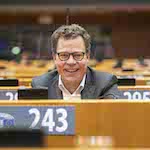
Lots of policy is still needed to secure investments in Europe’s green energy supply
Few, if any, policies I have negotiated as a Member of the European Parliament are as important as the Energy Union. Finally adopted by the Council in 2016, the Energy Union is not only a precondition for the EU Green Deal and our climate targets. From the beginning, the Energy Union was also about European security politics, and today, more than ever, it is apparent why dependence on energy import is problematic. In particular, if you are dependent on someone like Russia’s President Putin, who does not hesitate to use energy supplies as political leverage, way beyond the point of simple commercial trade. European self-supply of energy may be one of the single-most important pieces in the European pie of strategic autonomy, but in all honesty, we are a fair distance away of achieving this still.
It is quite the exercise too, since converting an entire continent’s energy supply from fossil fuels to sustainable, alternative energy sources is without prehistory. Yet, my experience is that funding for renewable energy projects is quite readily available, sometimes to a surprising extent. After all, the green transition is still young and, in many ways immature, and consequently it is still very much a ‘Wild West’ market for investors.
Take, for instance, the taxonomy instrument for classification of sustainable energy activities.
Right now, the taxonomy is at the centre of a highly polarised debate, where the tipping point between what is “green” and what is “black” is very difficult to pin down. Climate footprint reporting for companies is another area, where politics is still inconclusive, and therefore leaves green investments in the wind.
Predictability and stability are key words for investors in the green transition. It is important that we as politicians put an effort into creating transparent and stable policies that investors can rely on. Likewise, it is critical for the trust of investors that political goals, for example renewable energy targets, do not crumble and fall along the way.
The same kind of logic applies to red tape issues. Recently, I have been the rapporteur on the EU strategy on offshore renewables, and a major obstacle in the deployment of offshore windmills is very slow permitting, a problem occurring across the continent, which threatens the fulfilment of Europe’s climate targets. Investors take note of such issues too, and as politicians, we need to remove these obstacles, one by one, if necessary, in order to pave the way for more investments in the new green markets.
Making Europe energy independent with green energy is a tremendous task, because time is so scarce, and the required deployment is almost beyond imagination. However, my experience with the offshore renewable industry is that they have mature value chains, so the industry is ready, and there are investors around who are ready to fund the necessary upscaling. What they lack is updated regulatory frameworks.
Within offshore renewables this is for example, related to maritime spatial planning, while European energy independence as a whole also lacks common technical standards for the interconnectors, which makes sure the green energy can flow freely across borders.
Likewise, a revision of EU electricity market regulations is need to accommodate green investors, the green transition and the climate targets in the Green Deal.
I do not experience any lack of will amongst my colleagues in politics. The issue is simply that the task is gigantic, the time available short, and between the two, of course, democratic process needs to be respected. The covid-pandemic certainly did not help the legislative work either, and as a result, the European Parliament is looking at passing 3,800 pages of Fit for 55 legislation in the reminder of the period. That might break records.
The investors are out there, and it is not that surprising. Beyond historically low interest rates, which for some times have made, say, bonds less attractive as investments objects, the green transition is simply an extraordinary growth opportunity. If the green markets are still young, they are incredibly vibrant because there is gold to be found here, for businesses who win the market shares. As a society however, we want the competition to be tough, and have as many businesses in the market as possible to advance technologies, deliver better consumer prices and reduce public investments. This is what the regulatory frameworks should accommodate by shaping predictable and stable green markets, thus paving the way for European energy independence.




